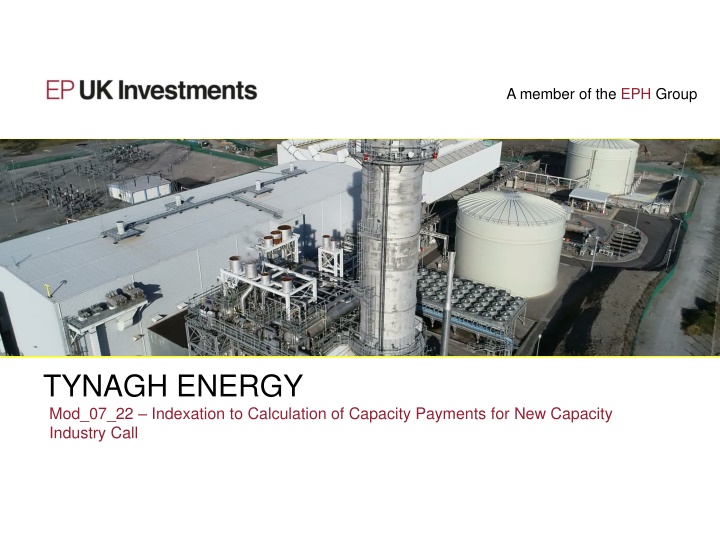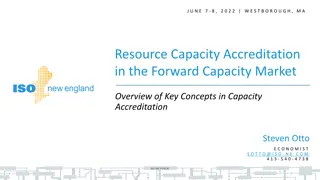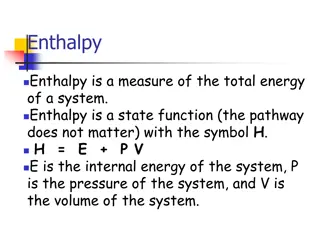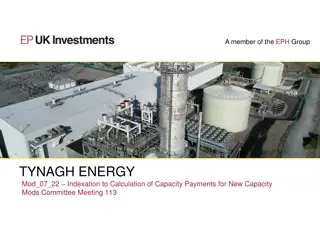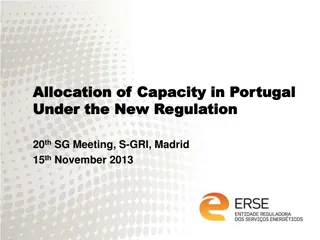Indexation for New Capacity Projects in Energy Industry
Recent inflationary pressures pose risks to new capacity projects in the energy industry. This modification aims to address rising construction and materials costs to ensure the efficient and economic operation of the Single Electricity Market, promoting competition and safeguarding the security of electricity supply.
Download Presentation

Please find below an Image/Link to download the presentation.
The content on the website is provided AS IS for your information and personal use only. It may not be sold, licensed, or shared on other websites without obtaining consent from the author.If you encounter any issues during the download, it is possible that the publisher has removed the file from their server.
You are allowed to download the files provided on this website for personal or commercial use, subject to the condition that they are used lawfully. All files are the property of their respective owners.
The content on the website is provided AS IS for your information and personal use only. It may not be sold, licensed, or shared on other websites without obtaining consent from the author.
E N D
Presentation Transcript
A member of the EPH Group TYNAGH ENERGY Mod_07_22 Indexation to Calculation of Capacity Payments for New Capacity Industry Call
Mod 07_22 Rationale for Modification Mod Rationale Recent inflationary pressure in construction and materials costs have created a significant risk to New Capacity projects set to be delivered in the coming year. Failure to address this issue will result in a significant Security of Supply risk which will likely come at a significant cost to consumers. When the CRM decision was made in 2015, it was deemed unnecessary to include indexation in Capacity Payments. This position was manageable up until the recent macroeconomic events which have driven up inflation, particularly related to construction and materials. Higher levels of inflation make it extremely difficult for participants to ensure that they can recover their costs, particularly given that Capacity contracts are secured three to four years in advance. Similar issues have already impacted RESS-1 in Ireland with only 630MW out of a total awarded 1,275MW of renewable contracts expected to energise by the end of this year. It is understood that a significant number of these projects are not expected to complete at all, given construction costs rising by 10-15% in the period since their contracts were awarded. The T-3 Auction was introduced to address existing Security of Supply concerns in the SEM. However, existing inflation rates means it is a possibility that many of the projects which secured contracts will not be able to build. Failure to secure this capacity will result in power shortfalls on the island of Ireland. This will likely result in emergency generation being required at a significant cost, and delivery risk to stakeholders. Tynagh Energy Limited 2
Mod 07_22 Rationale for Modification Mod Justification and Alignment with Code Objectives This modification is necessary to increase the likelihood of delivery of New Capacity. This modification aligns with the following TSC objectives: To facilitate the efficient, economic and coordinated operation, administration and development of the Single Electricity Market. In order to ensure the efficient and economic operation of the SEM, it is necessary that potential new participants can recover their costs through the various market channels. Failure to address this risk will jeopardise this. To facilitate the participation of electricity undertakings engaged in generation, supply or sale of electricity in the trading arrangements under the Single Electricity Market Current high inflation rates have created a significant barrier to entry for New Capacity projects, with a significant risk of costs spiralling during development. This acts as a disincentive for potential project developers who will not be able to accurately forecast such inflation rates. Failure to address this challenge will likely obstruct the participation of new generation undertakings in the SEM. To promote competition in the Single Electricity Market As above, it is necessary to address this risk to secure new participants, and hence competition, in the SEM. To promote the short-term and long-term interests of consumers of electricity on the island of Ireland with respect to price, quality, reliability, and Security of Supply of electricity. Addressing the challenge of rising inflation will significantly increase the likelihood of New Capacity being delivered in the SEM. This helps to address Security of Supply in the short-term and long-term. Additionally, we believe there is a price benefit to consumers in ensuring the delivery of planned capacity. Failure to secure New Capacity in a timely manner will mean the continued reliance on emergency generation to meet Ireland s Security of Supply needs. This results in significantly higher costs for consumers, for a temporary fix. Tynagh Energy Limited 3
Mod 07_22 Overview of Industry Call This modification seeks to address concerns which were raised at Mods Committee Meeting 111 on 16 June 2022. The specific issues to be addressed are: Is the TSC the most appropriate place for this modification, rather than the CMC?. Is the modification retrospective? Should the modification apply to inflation only or should it be bi-directional? Should the 2% included in the original modification proposal be hardcoded or variable? How will the modification interact with the Auction Price Cap? Appropriate indices? Should the modification apply to both New and Existing Capacity or New Capacity only? How will the modification apply to shorter-term Capacity? Should the modification (or elements of the modification) be technology specific? How long will it take to develop a solution? Tynagh Energy Limited 4
Mod 07_22 TSC or CMC? Some Committee Members questioned whether the modification was more suitable for inclusion in the TSC or the CMC? Section F.9.4.4 states that: The final Capacity Auction Results relating to a Participant are final and binding on that Participant . Section F.9.1.2 of the Capacity Market Code states: Except to the extent provided for in the Trading and Settlement Code, the Capacity Payment price shall not be subject to adjustment or indexation. We believe that it would be inappropriate to introduce this change in the CMC, given that the TSC is concerned with calculating Capacity Payments received by participants. We propose that this modification is further discussed at the CMC for information. CMC Results Capacity Auction Results TSC Capacity Payments Calculation - Present Awarded Capacity Associated with Unit. Awarded Capacity Associated with Unit. Capacity Payment Price Proposed Inflation Modifier Capacity Payment price for the relevant Unit. for Capacity Duration x x Capacity Duration for the relevant Unit. Tynagh Energy Limited 5
Mod 07_22 Is this mod retrospective? Some Committee members queried whether this modification would represent a retrospective change? Tynagh are cognisant of the fact that modifications in the TSC do not have retrospective effects. However, having considered the proposed amendment, we do not consider its effects to be retrospective. This is specifically because the modification affects the calculation of capacity payments, which take place in the present, to the remainder of the capacity contract. The Capacity Auction results themselves will remain unaffected. Calculation of Capacity Payments Proposed Inflation Adjustment Capacity Results Duration of Contract T-4 Years Present Tynagh Energy Limited 6
Mod 07_22 Upwards only, or bi-directional? Mods Committee members queried whether it is appropriate for the inflation amendment to apply in one direction only, or whether it should also account for deflation? The modification has been proposed to address the risk of New Capacity not being delivered. We believe that this risk is driven primarily by inflation (rather than deflation) which was why the original proposal was upwards only. However, we recognise the merit in having bi-directional movements. As such we believe that the equation applied to the mod can be amended as follows: F.17.1.2 The inflation modifier INFMOD, will be defined as: ???? 0.02 ,0 )??????? ?????? = (1 + max Will be amended to: F.17.1.2 The inflation modifier INFMOD, will be defined as: ?????? = (1 + (???? 0.02)??????? Tynagh Energy Limited 7
Mod 07_22 Operational Costs One participant suggested following the Mods Committee Meeting that the formula be amended to allow recovery of indexation of operating costs throughout the lifetime of the project. This would require the introduction of a new term to extend the indexation recovery for additional years. F.17.1.2 The inflation modifier INFMOD, will be defined as: ?????? = (1 + (???? 0.02)??????? If this change was accepted, the above formula would be amended to: F.17.1.2 The inflation modifier INFMOD, will be defined as: ?????? = (1 + ???? 0.02???????+??????? Where OPERIOD (Operational Period) is the length of time in years, between the date when Capacity Payments are calculated, and the date at which a capacity project reached substantial completion. Tynagh Energy Limited 8
Mod 07_22 Variability and Interaction with Auction Price Caps Members queried whether the baseline indexation should be fixed or variable and how it would interact with the ACP. There are a number of possible approaches to setting the baseline inflation within the modification. 1. Fixed Inflation Rate: The current drafting of the modification is based on a fixed value of 2% based on SEM-21-110. This has potential implications if further indexation is applied to future Auction Price Caps. 2. Variable Indexation Based on Auction Price Cap: The baseline indexation could be based on the any indexation included in the Auction Price Cap for future auctions. This would allow developers to price some indexation into their bids, with the difference applying to the calculation of Capacity Payments. 3. Derived Indexation Based on Auction Price Cap: Indirectly calculated indexation rate based on the difference between relevant auction Price Caps at time of award and time of completion. (Where x is the difference in years between auctions): 1 ? ????? ??? ?? ??? ????? ??? ?? ??? ? ?????????? = -1 Tynagh Energy Limited 9
Mod 07_22 Appropriate Indices Mods Committee members queried what indices is most appropriate to apply. Given that the SEM is a multi-jurisdictional market it may be appropriate to use a blend of indices accounting for inflation in both Ireland and Northern Ireland. We propose that the indices used should reflect construction and materials related costs, as these are the most relevant cost areas for new capacity projects. For reference, in Ireland the Tender Price Index (TPI) is an assessment of construction tender prices. The UK applies Construction Output Prices Indices (OPI) to reflect inflation within the construction industry. There are a range of indices covered by these statistics, we consider New Work Infrastructure to be the most appropriate. We propose either using a 50/50 blend, or a 75/25 blend of the above indices. We have no preference at this time, but consider it important that the chosen rate most accurately represents construction price movements within the SEM. Tynagh Energy Limited 10
Mod 07_22 Appropriate Indices (Example) The following example demonstrates how the average annualized inflation would be calculated, using hypothetical inflation rates for both jurisdictions. Indices 2022 2023 2024 2025 6% 4% 8% 9% TPI (IE) 5% 5% 6% 7% OPI NWI (NI) 5.5% 4.5% 7.0% 8.0% 50/50 Blend 5.8% 4.3% 7.5% 8.5% 75/25 Blend These results would provide the following results for each blend respectively: 5.5 0.75 + 4.5 + 7.0 + (8.0 0.75) 3.5 ??????? ?????????? ????????? 50 50 = = ?.?% 5.8 0.75 + 4.3 + 7.5 + (8.5 0.75) 3.5 ??????? ?????????? ????????? 75 25 = = ?.?% Tynagh Energy Limited 11
Mod 07_22 New vs. Existing Capacity and Short-Term Mods Committee members queried whether it is appropriate for the modification to apply to both New and Existing Capacity, or New Capacity only? Open to further discussion at the Capacity Modifications Workshop. We believe the modification is most appropriate for New Capacity only, firstly because of the objective to secure investment in delivery of Security of Supply, and secondly because New Capacity projects are most likely to be exposed to rising construction costs. If this adjustment will be applied to Existing Capacity, it will be necessary to adjust the Construction Period (CPERIOD) variable in the equation to reflect the necessary period (i.e., 3.5 years for New Capacity, or 1 year for Existing Capacity). It is unclear whether it would be possible, within the TSC to apply the modification to New Capacity only. Additionally, members queried how the modification would apply to shorter-term Capacity delivery (i.e., T-1). Our initial position is that this modification is not required for Capacity being delivered in a one year period, or Capacity extensions. While there is a degree of exposure for such projects, we believe it is minimised given that the timeframe for construction is shorter than a T-3 or T-4 project. Tynagh Energy Limited 12
Mod 07_22 Technology Specific? Should the modification, or elements of the modification be technology specific or variable? Consideration was given to this question after the Mods Committee meeting. We do not think it is appropriate to make any elements of the modification technology-specific. Neither the Trading and Settlement Code or the Capacity Market Code are discriminatory toward certain technology types. Tynagh Energy Limited 13
Mod 07_22 Time to Solution? Committee Members expressed concern around the amount of time required to implement the solution, given the urgency with which this mod may be require. If passed, this modification will need to be delivered with urgency in order to avoid Security of Supply issues in the short-term. This will increase the likelihood of New Capacity connecting to the grid. There is a significant volume of flexible conventional generation which secured Capacity in the T-3 and T-4 Capacity Auctions. These projects are and will continue to be exposed to significant risk as a result of current inflation rates leading to spiralling construction costs. Failure to address this challenge will likely result in the continued need for emergency generation, at significantly higher cost to the consumer. This modification will be discussed at the July Capacity Modifications Committee, before being re-tabled for discussion and voting at the Balancing Modifications Committee 112. Tynagh Energy Limited 14
Mod 07_22 Next Steps We propose the following Next Steps to progress this modification proposal: Discussion at the July Capacity Modifications Committee. While we believe this modification is more appropriate for inclusion in the TSC, than the CMC, we believe it is worth discussing at the Capacity Workshop as it will affect Capacity Payments if implemented. Deferred to Mods Committee Meeting 112 in September. Pending outcome of the Capacity Workshop and discussion today we will amend the modification proposal for discussion/voting at the next Mods Committee Meeting. Tynagh Energy Limited 15
